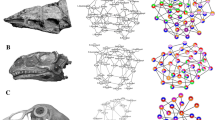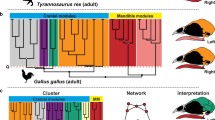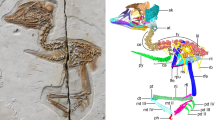Abstract
Radical transformation of the skull characterizes bird evolution. An increase in the relative size of the brain and eyes was presumably related to the loss of two bones surrounding the eye, the prefrontal and postorbital. We report that ossification centres of the prefrontal and postorbital are still formed in bird embryos, which then fuse seamlessly to the developing nasal and frontal bones, respectively, becoming undetectable in the adult. The presence of a dinosaur-like ossification pattern in bird embryos is more than a trace of their evolutionary past: we show how persistent modularity of ossification centres has allowed for evolutionary re-organization of skull architecture in evolution. Our findings also demonstrate that enigmatic mesodermal cells forming the posterior region of the avian frontal correspond to the ossification centre of the postorbital, not the parietal, and link its failure to develop into an adult bone to its incorporation into the expanded braincase of birds.
This is a preview of subscription content, access via your institution
Access options
Access Nature and 54 other Nature Portfolio journals
Get Nature+, our best-value online-access subscription
$29.99 / 30 days
cancel any time
Subscribe to this journal
Receive 12 digital issues and online access to articles
$119.00 per year
only $9.92 per issue
Buy this article
- Purchase on Springer Link
- Instant access to full article PDF
Prices may be subject to local taxes which are calculated during checkout





Similar content being viewed by others
Data availability
High-resolution photographs of the specimens are available in the figures and also can be provided by request.
References
Sidor, C. A. Simplification as a trend in synapsid cranial evolution. Evolution 55, 1419–1442 (2001).
Gregory, W. K. ‘Williston’s law’relating to the evolution of skull bones in the vertebrates. Am. J. Phys. Anthropol. 20, 123–152 (1935).
Koyabu, D., Maier, W. & Sanchez-Villagra, M. R. Paleontological and developmental evidence resolve the homology and dual embryonic origin of a mammalian skull bone, the interparietal. Proc. Natl Acad. Sci. USA 109, 14075–14080 (2012).
Bhullar, B.-A. S. et al. How to make a bird skull: major transitions in the evolution of the avian cranium, paedomorphosis, and the beak as a surrogate hand. Integr. Comp. Biol. 56, 389–403 (2016).
Erdmann, K. Zur entwicklungsgeschichte der knochen im schädel des huhnes bis zum zeitpunkt des ausschlüpfens aus dem ei. Zoomorphology 36, 315–400 (1940).
Maxwell, E. E. & Larsson, H. C. E. Comparative ossification sequence and skeletal development of the postcranium of palaeognathous birds (Aves: Palaeognathae). Zool. J. Linn. Soc. 157, 169–196 (2009).
Webb, M. The ontogeny of the cranial bones, cranial peripheral and cranial parasympathetic nerves, together with a study of the visceral muscles of struthio. Acta Zool. 38, 81–203 (1957).
Parker, T. J. Observations on the anatomy and development of Apteryx. Phil. Trans. R. Soc. B 182, 25–134 (1889).
Parker, T. J. Additional observations on the development of Apteryx. Phil. Trans. R. Soc. B 183, 73–84 (1892).
Parker, W. K. On the structure and development of the skull in the ostrich tribe. Phil. Trans. R. Soc. B 156, 113–183 (1866).
Maxwell, E. E. Ossification sequence of the avian order Anseriformes, with comparison to other precocial birds. J. Morphol. 269, 1095–1113 (2008).
Starck, J. M. in Current Ornithology Vol. 10 (ed. Power, M.) Ch. 6 (Springer, Boston, 1993).
Maxwell, E. E. Comparative embryonic development of the skeleton of the domestic turkey (Meleagris gallopavo) and other galliform birds. Zoology 111, 242–257 (2008).
Parker, W. K. On the structure and development of the skull of the common fowl (Gallus domesticus). Phil. Trans. R. Soc. B 159, 755–807 (1869).
Jollie, M. T. The head skeleton of the chicken and remarks on the anatomy of this region in other birds. J. Morphol. 100, 389–436 (1957).
Nakane, Y. & Tsudzuki, M. Development of the skeleton in Japanese quail embryos. Dev. Growth Differ. 41, 523–534 (1999).
Maxwell, E. E. & Harrison, L. B. Ossification sequence of the common tern (Sterna hirundo) and its implications for the interrelationships of the Lari (Aves, Charadriiformes). J. Morphol. 269, 1056–1072 (2008).
Maxwell, E. E., Harrison, L. B. & Larsson, H. C. Assessing the phylogenetic utility of sequence heterochrony: evolution of avian ossification sequences as a case study. Zoology 113, 57–66 (2010).
Maxwell, E. E. Evolution and Avian Ossification Sequences. PhD thesis, McGill Univ. (2008).
Baumel, J. & Witmer, L. in Handbook of Avian Anatomy: Nomina Anatomica Avium (ed. Baumel, J.) 45–132 (Publications of the Nuttall Ornithological Club, Cambridge, 1993).
Rieppel, O. Studies on skeleton formation in reptiles. v. Patterns of ossification in the skeleton of Alligator mississippiensis Daudin (Reptilia, Crocodylia). Zool. J. Linn. Soc. 109, 301–325 (1993).
Sereno, P. C. & Novas, F. E. The skull and neck of the basal theropod Herrerasaurus ischigualastensis. J. Vertebr. Paleontol. 13, 451–476 (1994).
Colbert, E. H. The Triassic Dinosaur Coelophysis (Museum of Northern Arizona Press, Northern Arizona Society of Science and Art, Flagstaff, 1989).
Nesbitt, S. J. et al. A complete skeleton of a Late Triassic saurischian and the early evolution of dinosaurs. Science 326, 1530–1533 (2009).
Currie, P. J. Cranial anatomy of tyrannosaurid dinosaurs from the Late Cretaceous of Alberta, Canada. Acta Palaeontol. Pol. 48, 191–226 (2003).
Brochu, C. A. Osteology of Tyrannosaurus rex: insights from a nearly complete skeleton and high-resolution computed tomographic analysis of the skull. J. Vertebr. Paleontol. 22, 1–138 (2003).
Peyer, K. A reconsideration of Compsognathus from the Upper Tithonian of Canjuers, southeastern France. J. Vertebr. Paleontol. 26, 879–896 (2006).
Lautenschlager, S., Witmer, L. M., Altangerel, P., Zanno, L. E. & Rayfield, E. J. Cranial anatomy of Erlikosaurus andrewsi (Dinosauria, Therizinosauria): new insights based on digital reconstruction. J. Vertebr. Paleontol. 34, 1263–1291 (2014).
Choiniere, J. N., Clark, J. M., Norell, M. A. & Xu, X. Cranial osteology of Haplocheirus sollers Choiniere et al., 2010 (Theropoda: Alvarezsauroidea). Am. Mus. Novit. 51, 1–44 (2014).
Chiappe, L. M., Norell, M. A. & Clark, J. M. The skull of a relative of the stem-group bird Mononykus. Nature 392, 275–278 (1998).
Turner, A. H., Makovicky, P. J. & Norell, M. A. A review of dromaeosaurid systematics and paravian phylogeny. B. Am. Mus. Nat. Hist. 371, 1–206 (2012).
Foth, C., Tischlinger, H. & Rauhut, O. W. New specimen of Archaeopteryx provides insights into the evolution of pennaceous feathers. Nature 511, 79–82 (2014).
Sues, H.-D. The skull of Velociraptor mongoliensis, a small Cretaceous theropod dinosaur from Mongolia. Paläont. Z. 51, 173–184 (1977).
Gao, C., Morschhauser, E. M., Varricchio, D. J., Liu, J. & Zhao, B. A second soundly sleeping dragon: new anatomical details of the Chinese troodontid Mei long with implications for phylogeny and taphonomy. PLoS ONE 7, e45203 (2012).
Makovicky, P. J., Norell, M. A., Clark, J. M. & Rowe, T. Osteology and relationships of Byronosaurus jaffei (Theropoda: Troodontidae). Am. Mus. Novit. 3402, 1–32 (2003).
Bever, G. S. & Norell, M. A. The perinate skull of Byronosaurus (Troodontidae) with observations on the cranial ontogeny of paravian theropods. Am. Mus. Novit. 3657, 1–52 (2009).
Xu, X., Wang, X.-L. & Wu, X.-C. A dromaeosaurid dinosaur with a filamentous integument from the Yixian Formation of China. Nature 401, 262–266 (1999).
Burnham, D. A. in Feathered Dragons: Studies on the Transition from Dinosaurs to Birds (ed. Currie, P. J.) 67–111 (Indiana Univ. Press, Bloomington, 2004).
Ostrom, J. H. Osteology of Deinonychus antirrhopus, an Unusual Theropod from the Lower Cretaceous of Montana Vol. 30 (Peabody Museum of Natural History, Yale Univ. Press, New Haven, 1969).
Norell, M. A. et al. A new dromaeosaurid theropod from Ukhaa Tolgod (Ömnögov, Mongolia). Am. Mus. Novit. 3545, 1–51 (2006).
Barsbold, R. & Osmólska, H. The skull of Velociraptor (Theropoda) from the Late Cretaceous of Mongolia. Acta Palaeontol. Pol. 44, 189–219 (1999).
Currie, P. J. & Zhiming, D. New information on Cretaceous troodontids (Dinosauria, Theropoda) from the People’s Republic of China. Can. J. Earth Sci. 38, 1753–1766 (2001).
Maxwell, W. & Witmer, L. New material of Deinonychus (Dinosauria; Theropoda). J. Vertebr. Paleontol. 16, 51A (1996).
Lü, J. et al. A new oviraptorid dinosaur (Dinosauria: Oviraptorosauria) from the Late Cretaceous of Southern China and its paleobiogeographical implications. Sci. Rep. 5, 11490 (2015).
Lü, J., Tomida, Y., Azuma, Y., Dong, Z. & Lee, Y.-N. New oviraptorid dinosaur (Dinosauria: Oviraptorosauria) from the Nemegt Formation of southwestern Mongolia. Bull. Nat. Sci. Mus. Tokyo Ser. C 30, 95–130 (2004).
Elzanowski, A. A novel reconstruction of the skull of Archaeopteryx. Neth. J. Zool. 51, 207–215 (2001).
Rauhut, O. W. New observations on the skull of Archaeopteryx. Paläont. Z. 88, 211–221 (2014).
Elzanowski, A. & Wellnhofer, P. Cranial morphology of Archaeopteryx: evidence from the seventh skeleton. J. Vertebr. Paleontol. 16, 81–94 (1996).
Tischlinger, H. Neue informationen zum berliner exemplar von Archaeopteryx lithographica H. v. Meyer 1861. Archaeopteryx 23, 33–50 (2005).
Wellnhofer, P. Das fünfte skelettexemplar von Archaeopteryx. Palaeontogr. Abt. A A147, 168–216 (1974).
Mayr, G., Pohl, B. & Peters, D. S. A well-preserved Archaeopteryx specimen with theropod features. Science 310, 1483–1486 (2005).
Rauhut, O. W., Foth, C. & Tischlinger, H. The oldest Archaeopteryx (Theropoda: Avialiae): a new specimen from the Kimmeridgian/Tithonian boundary of Schamhaupten, Bavaria. PeerJ 6, e4191 (2018).
Wang, M. & Hu, H. A comparative morphological study of the jugal and quadratojugal in early birds and their dinosaurian relatives. Anat. Rec. 300, 62–75 (2017).
Bhullar, B. A. et al. Birds have paedomorphic dinosaur skulls. Nature 487, 223–226 (2012).
Field, D. J. et al. Complete Ichthyornis skull illuminates mosaic assembly of the avian head. Nature 557, 96–100 (2018).
O’Connor, J. K. & Chiappe, L. M. A revision of enantiornithine (Aves: Ornithothoraces) skull morphology. J. Syst. Palaeontol. 9, 135–157 (2011).
Gould, S. J. Hen’s Teeth and Horse’s Toes: Further Reflections in Natural History (WW Norton & Company, New York, 2010).
Ossa-Fuentes, L., Mpodozis, J. & Vargas, A. O. Bird embryos uncover homology and evolution of the dinosaur ankle. Nat. Commun. 6, 8902 (2015).
Diaz, R. E. & Trainor, P. A. Hand/foot splitting and the ‘re-evolution’ of mesopodial skeletal elements during the evolution and radiation of chameleons. BMC Evol. Biol. 15, 184 (2015).
Wake, D. B. Homoplasy: the result of natural selection, or evidence of design limitations? Am. Nat. 138, 543–567 (1991).
Le Lièvre, C. S. & Le Douarin, N. Mesenchymal derivatives of the neural crest: analysis of chimaeric quail and chick embryos. Development 34, 125–154 (1975).
Le Lievre, C. S. Participation of neural crest-derived cells in the genesis of the skull in birds. J. Embryol. Exp. Morphol. 47, 17–37 (1978).
Noden, D. M. The role of the neural crest in patterning of avian cranial skeletal, connective, and muscle tissues. Dev. Biol. 96, 144–165 (1983).
Evans, D. J. & Noden, D. M. Spatial relations between avian craniofacial neural crest and paraxial mesoderm cells. Dev. Dyn. 235, 1310–1325 (2006).
Piekarski, N., Gross, J. B. & Hanken, J. Evolutionary innovation and conservation in the embryonic derivation of the vertebrate skull. Nat. Commun. 5, 5661 (2014).
Maddin, H. C., Piekarski, N., Sefton, E. M. & Hanken, J. Homology of the cranial vault in birds: new insights based on embryonic fate-mapping and character analysis. R. Soc. Open Sci. 3, 160356 (2016).
Noden, D. M. & Schneider, R. A. in Neural Crest Induction and Differentiation (ed. Saint-Jeannet, J.-P.) 1–23 (Landes Bioscience, Georgetown and Springer, New York, 2006).
Fabbri, M. et al. The skull roof tracks the brain during the evolution and development of reptiles including birds. Nat. Ecol. Evol. 1, 1543 (2017).
Hamburger, V. & Hamilton, H. L. A series of normal stages in the development of the chick embryo. J. Morphol. 88, 49–92 (1951).
Hays, H. & LeCroy, M. Field criteria for determining incubation stage in eggs of the common tern. Wilson Bull. 83, 425–429 (1971).
Hall, B. & Miyake, T. The membranous skeleton: the role of cell condensations in vertebrate skeletogenesis. Anat. Embryol. 186, 107–124 (1992).
Hall, B. K. & Miyake, T. Divide, accumulate, differentiate: cell condensation in skeletal development revisited. Int. J. Dev. Biol. 39, 881–893 (2004).
Yamazaki, Y., Yuguchi, M., Kubota, S. & Isokawa, K. Whole-mount bone and cartilage staining of chick embryos with minimal decalcification. Biotech. Histochem. 86, 351–358 (2011).
Gingerich, P. Skull of Hesperornis and early evolution of birds. Nature 243, 70–73 (1973).
Acknowledgements
We wish to thank B.-A. Bhullar for kindly allowing us to examine and photograph embryos of A. mississippiensis. Special thanks go to M. Sallaberry and J. Mpodozis at Universidad de Chile. This work was funded by grants Anillo ACT172099 and Fondecyt 1150906 (Conicyt, Government of Chile) to A.O.V. This work is dedicated to the memory of Professor Juan Fernández Hidalgo.
Author information
Authors and Affiliations
Contributions
D.S.-P. and A.O.V. conceived and planned the research. D.S.-P. and D.N.-L. collected, cleared and stained embryos and analysed embryological data. D.S.-P., S.S.-A. and J.O. analysed fossil specimens and palaeontological data. D.S.-P., D.N.-L., S.S.-A., J.O., J.F.B. and A.O.V contributed to the writing of the paper.
Corresponding authors
Ethics declarations
Competing interests
The authors declare no competing interests.
Additional information
Publisher’s note: Springer Nature remains neutral with regard to jurisdictional claims in published maps and institutional affiliations.
Supplementary information
Supplementary Information
Supplementary Tables and Figures
Rights and permissions
About this article
Cite this article
Smith-Paredes, D., Núñez-León, D., Soto-Acuña, S. et al. Dinosaur ossification centres in embryonic birds uncover developmental evolution of the skull. Nat Ecol Evol 2, 1966–1973 (2018). https://doi.org/10.1038/s41559-018-0713-1
Received:
Accepted:
Published:
Issue Date:
DOI: https://doi.org/10.1038/s41559-018-0713-1
This article is cited by
-
Conserved in-ovo cranial ossification sequences of extant saurians allow estimation of embryonic dinosaur developmental stages
Scientific Reports (2020)
-
Evolutionary and ontogenetic changes of the anatomical organization and modularity in the skull of archosaurs
Scientific Reports (2020)
-
Birds have peramorphic skulls, too: anatomical network analyses reveal oppositional heterochronies in avian skull evolution
Communications Biology (2020)



